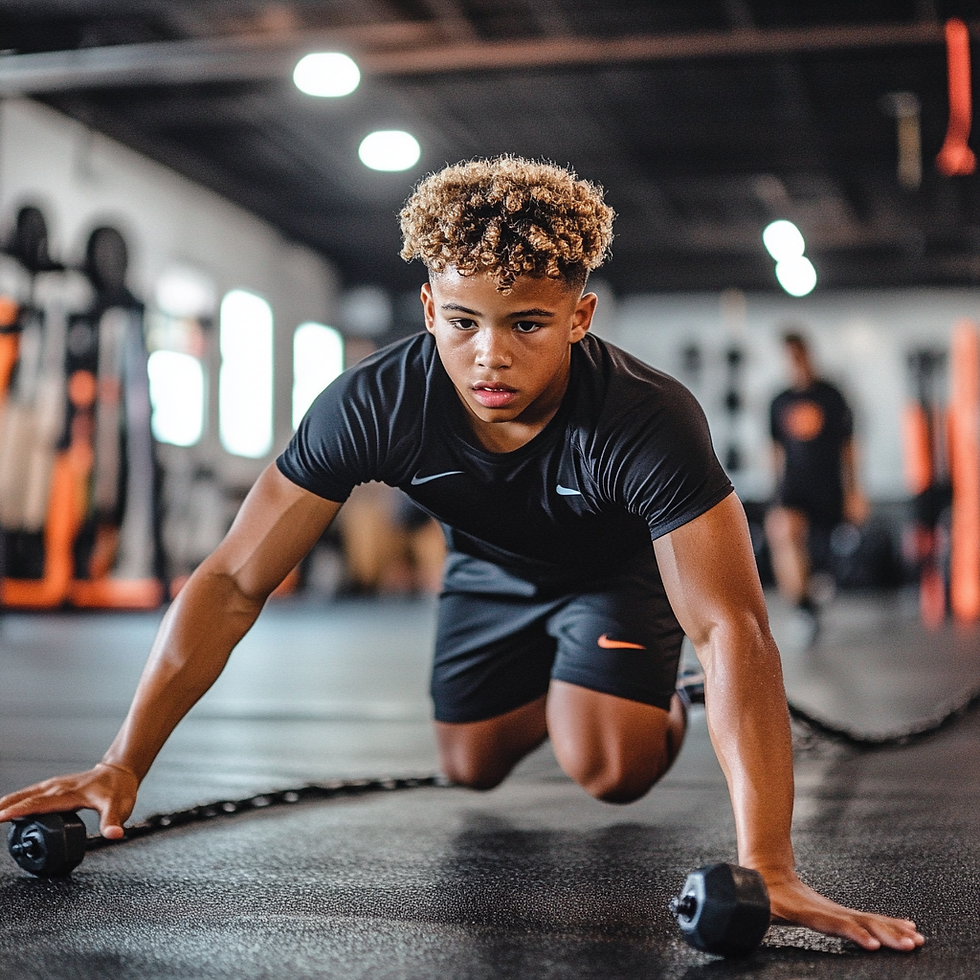🧠 The Ultimate Reaction Training Drills for Youth Athletes
- Dérik
- Apr 16
- 3 min read

⚡ Why Reaction Training Matters in Youth Sports
Quick decisions win games. Whether it's dodging a defender or reacting to a whistle, reaction training drills for youth athletes help sharpen reflexes, improve coordination, and build that competitive edge. They're essential for sports like soccer, basketball, football, Jiu-Jitsu, and even swimming.
Sports That Challenge Your Reaction Speed:
Sport | Reaction Time Demand | Why It Matters |
Soccer | Extremely fast (under 0.3 seconds) | Quick decisions on ball direction, opponent movements, and passing. |
Basketball | Fast (under 0.5 seconds) | Reacting to opponent’s plays, passes, and shots. |
Football | Quick (under 0.5 seconds) | Reacting to plays, tackles, and interceptions. |
Jiu-Jitsu | Medium to fast (under 0.5 seconds) | Quick counters, submission reactions, and opponent’s movements. |
Tennis | Fast (under 0.3 seconds) | Reacting to serves, volleys, and ball direction. |
Swimming | Moderate (0.5–1 second) | Reacting to the start signal, turns, and pacing. |
Hockey | Extremely fast (under 0.3 seconds) | Reacting to puck direction, opponent movements, and play changes. |
Volleyball | Fast (under 0.5 seconds) | Reacting to serves, blocks, and quick spikes. |
Boxing | Extremely fast (under 0.3 seconds) | Reacting to punches, defensive moves, and strikes. |
Baseball | Quick (under 0.5 seconds) | Reacting to pitches, balls, and fielding situations. |
Rugby | Fast (under 0.5 seconds) | Reacting to plays, tackles, and passes. |
Lacrosse | Fast (under 0.5 seconds) | Reacting to ball direction, opponent moves, and passes. |
🏃♂️ Top 5 Reaction Training Drills for Youth Athletes
1. Color Cone Reaction
Set up multiple colored cones. Call out a color randomly, and the athlete sprints to touch that cone.
Improves: Visual processing and directional speed
2. Mirror Drill
Two athletes face each other. One leads with quick lateral movements while the other mirrors them.
Improves: Reaction speed and agility
3. Ball Drop Drill
Drop a tennis ball or small object and have the athlete catch it before it bounces twice.
Improves: Hand-eye coordination and quick reflexes
4. Reaction Light App
Use apps like BlazePod or even flashlight apps. Tap the light as soon as it flashes.
Improves: Visual reaction speed and focus
5. Command Sprint
Give random commands like "left!", "right!", or “go!” while athletes jog. They must react instantly.
Improves: Audio reaction time and cognitive processing
Here’s a full benchmark table for all the reaction training drills mentioned:
Drill Name | Benchmark (Time/Performance) | Rating |
Ball Drop Catch Time | Catch the ball under 0.3 seconds | Excellent |
Visual Cue Response (Light) | Respond to light cue within 0.25–0.35 seconds | Above Average |
Command Sprint Delay | Immediate movement (within 1 second of command) | Excellent |
Color Cone Reaction | Touch the cone within 1 second of the command | Good |
Mirror Drill Reaction Speed | Respond to partner's movement within 1 second | Excellent |
This table can be used to track the athlete’s performance and show progress as they work through the drills.
🔗 Top Reaction Light Apps for Athletic Training

🧪 How to Measure Reaction Time Progress
Try these simple benchmarks:
Ball Drop Catch Time: Under 0.3 seconds = Excellent
Visual Cue Response (Light): 0.25–0.35 seconds = Above average
Command Sprint Delay: Instant movement within 1 second
Track results weekly to see improvement.
🏠 DIY Equipment Ideas for Reaction Training
You don’t need expensive gear to do reaction training drills for youth athletes:
✅ See on Amazon Colored cones or cups
✅ See on Amazon Tennis balls
✅ See on Amazon Flashlight or LED light apps
✅ See on Amazon A whistle or your own voice
💡 Affordable Home Equipment for Athletic Training

🏁 Final Tips for Coaches and Parents
Make it a game. Keep it fun. Rotate drills weekly and incorporate these drills into warm-ups. Short, intense reps (30–60 seconds) with 1-minute breaks keep the brain and body sharp.
➡️ Next up
🟢 DIY Reaction Time Tests & How to Track Progress (coming soon)
.png)


Comments